Intel Core 2 CULV Roundup: Who Needs Atom?
by Jarred Walton on February 4, 2010 4:00 AM ESTBlending Battery Life with Performance
We just showed how CULV skunks Atom when it comes to performance. Dual-core Atom 330 is still quite a bit slower, and it's not even close when we look at the mobile Atom CPUs. This is all from a relatively "weak" 1.3GHz Core 2 processor. But Atom CPUs have a TDP of just 2.5W for N280 and 5.5W for N450 (the latter also includes the chipset, so it actually uses less power than N280 + 945GSE); meanwhile, CULV is listed as having a TDP of 10W. Advantage: Atom, right? Well, not so fast. The newer Pine Trail platform definitely helps, with a much lower power draw from the chipset and graphics. Max TDP doesn't necessarily correlate well to idle or low use TDP, though, which is where most users tend to operate their PCs. Here's how battery life stacks up.
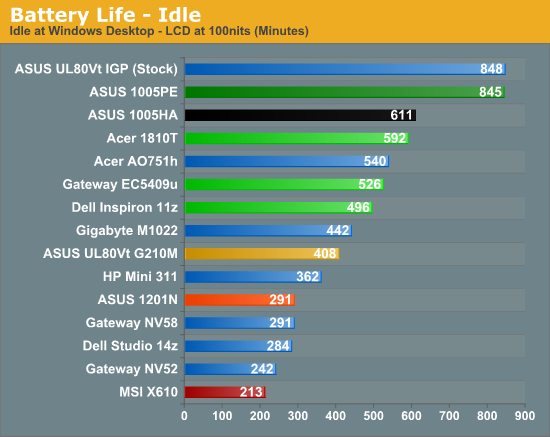
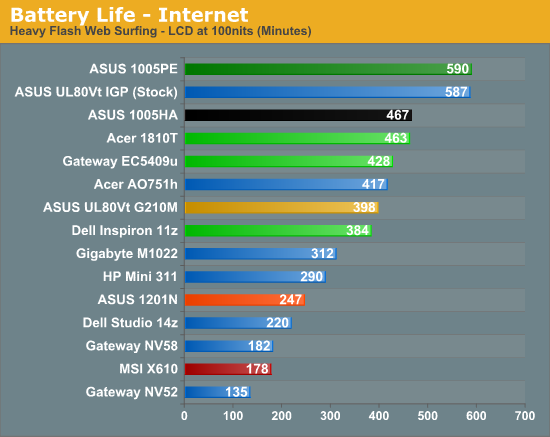
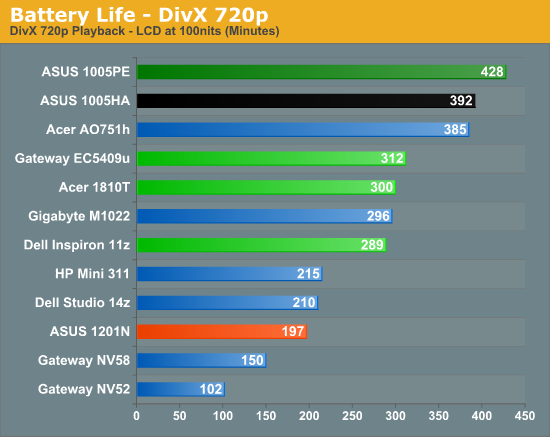
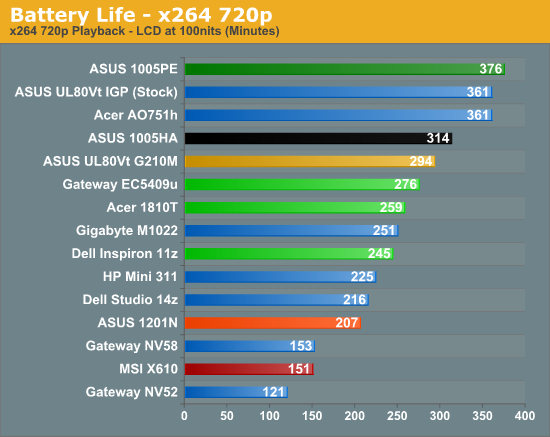
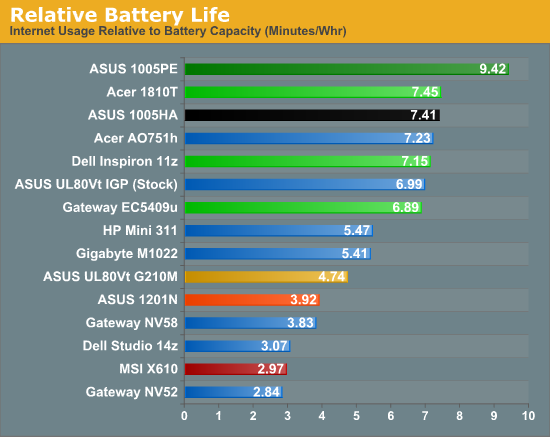
We gained performance but we do give up a bit in battery life - at least when we look at Pine Trail. The smaller CULV laptops like the Acer AS1810T are able to come very close to Atom N280 battery life in the Idle and Internet tests, while the video playback results still favor N280 (provided you're not trying to do 1080p H.264). Atom N450 on the other hand manages to boost battery life by anywhere from 10% (DivX) to 40% (Idle), putting it out of reach of CULV when both are using similar capacity batteries.
The AS1810T delivers an impressive result in our Heavy Internet Browsing test, coming in just shy of eight hours at 463 minutes. That's a virtual tie with the older Atom N280 based ASUS 1005HA (467 minutes), indicating CULV is able to render the web pages and get to a deep sleep state faster than N280. The newer ASUS 1005PE Pine Trail netbook still bests the AS1810T by just over two hours (590 minutes), so if you want maximum battery life Atom continues to beat the other Intel processors. The other CULV options both trail the AS1810T, which is expected. The EC5409u is larger and so the LCD will draw more power, while the Dell 11z has a slightly lower capacity battery.
In terms of relative battery life (and of course, we should note that we're going off the advertised battery capacities, which may be slightly off), the CULV and most N280 offerings are clustered tightly together. While the EC5409u does use more power, the DDR3 memory appears to mitigate that somewhat, with overall battery life still very close to the smaller laptops. Pine Trail is at its best in Idle battery life, but the Internet test is another strong point: it gets 25% more battery life compared to CULV for the same battery capacity.
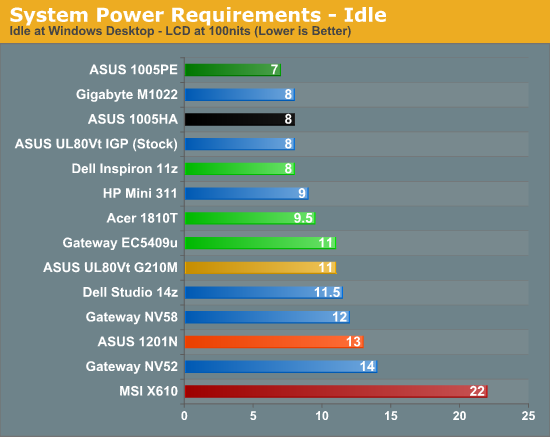
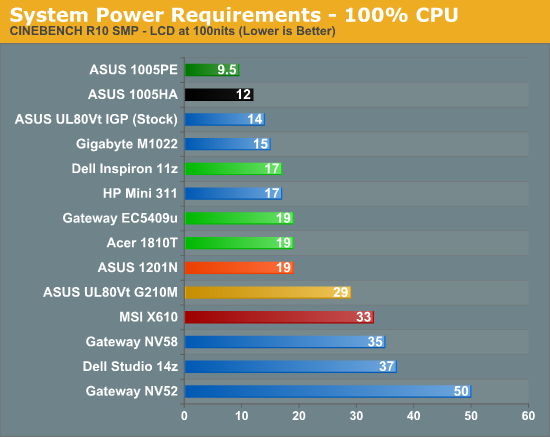
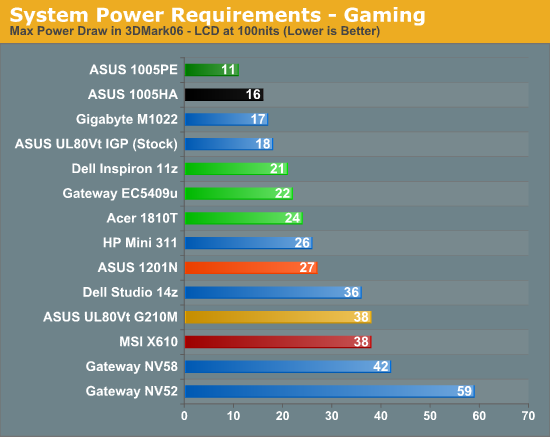
Looking at power requirements helps clear up any lingering questions. Mobile Atom CPUs are designed to sip power, with their highest load sucking down around 4W for N450 and 7W for N280 (including chipset power draw). We estimate that at idle, Atom N280 uses 1W, the chipset probably uses 2W, LCD gets 3W, and the remainder is divvied up among the other bits and pieces. Atom N450 can cut another 1W from Idle power requirements, which is at least a 15% reduction (and possibly more, given our tools are only accurate to at best .5W). In contrast, a CULV CPU can idle very well, but under load the power draw jumps significantly. The AS1810T looks like it uses every bit of its 10W max TDP. Add on graphics and the gap widens even more, though here we need to mention that GMA 950/3150 are a very big step down from GMA 4500MHD (which is another big step back from something like GeForce 9400M).
Overall, it appears that CULV processors are very similar in terms of idle power requirements when compared to Atom N280, especially once we factor in chipsets. As we mentioned above, in many situations an application will need to do a set amount of work as quickly as possible (e.g. rendering a web page), after which the CPU can go into a deep sleep state. The faster the work gets done, the sooner the CPU can sleep, and the net result is that even in moderate loads CULV can compete quite well against N280. The catch is that there are other loads (like video decoding) where CULV ends up using quite a bit more power than Atom, but in common usage scenarios the battery life is still very good.










62 Comments
View All Comments
yyrkoon - Thursday, February 4, 2010 - link
Jarred. Without even having to read the article/comparison here, I could have told you this would have been a no brainer.Last year I purchased a Toshiba Laptop with a T3400 CPU in it for less than $400( barely ) with free shipping. Now technically, this CPU is labeled as a "Pentium dual core. What that means exactly, I am not sure. But what I can tell you about this complete system is that at max load, it draws less than 40W( 17W light duty / idle ), and will play all but the most intense games reasonably well.
Now what really surprised me about this laptop, after the fact that I did not think it could even play Hellgate: london( and it does, well, mostly ). Was that it encodes h264 video at close to the same speed as my desktop. Granted, my desktop is somewhat aged, but is no slouch. A P35 based system running an E6550 with 4GB of ram. Over Clocked to run 1:1 with the memory( 2.8Ghz ). Now perhaps I am missing something here, like perhaps Handbrake is not the best app to use to encode h264 ( x264 ), or maybe I am missing something else. Either way, I am fairly impressed. Which as I get older is something that is not as easy as it once was to do.
So my point here, is that if an older system based off older technology can do well in this arena. I can see why newer technology can put the Atom to shame for a slightly higher price, and slight higher power consumption.
One thing that does have me confused. Is why vendors/ OEM's have not implemented low power / performance parts for the common desktop. There certainly is an interest, all one has to do is search the web for a while and find 1000's of people out there trying to do different various things along these lines.
For instance. Many of us possibly know that getting a low power desktop is not much of a challenge(read: ~50W full load, including an LCD ). However, popping in a discrete video card that has any sort of decent performance will more than likely triple your load at the wall. Why nVIdia/ATI insist on bleeding us dry with costs on the cards, and then insult us further by requiring us to buy an even bigger power supply. Not to mention the first born children we're obligated to give our local power companies for powering such beasts. Is it too much of a stretch of imagination to put a mobile graphics processor on a PCI-E 16x PCB ? I think not.
With the above said. No, this does not imply gaming. Discrete graphics vs. integrated / onboard is a huge performance gain on its own. There are many different application out there that could benefit from this, and gaming is just a minor part of that.
Souka - Thursday, February 4, 2010 - link
My brother bought a HPmini netbook for our Mom, she hated how slow and unresponsive it was.All she did on it was read her hotmail, look at some gardening sites, and read the news... She was quite disappointed how slow it was compared to her 8 year old Pentium4 thinkpad laptop.
I tweaked it best I could for performance, cpu typically wasn't very busy, 200mb+ free ram, hard drive not too busy... just plain sluggish.
I even removed the Antivirus and all unecssary runtime apps... no noticible difference
Ended up getting her a cute little used Sony Vaio ULV book... she loves it...and I paid just a bit more than the netbook.
Oh yeah...the Vaio gets 5-8hrs run time on used battery... nice
Mumrik - Thursday, February 4, 2010 - link
The display is "11.6" LED Glossy 16:9 768p (1366x768)" in the box for the Gateway. It should be 15.x...aglennon - Thursday, February 4, 2010 - link
I always wondered, Would battery life when playing videos be longer if you played the videos off of a flash drive rather than the hard drive?You could put the hard drive to sleep to save on the battery draw. Or would you?
JarredWalton - Friday, February 5, 2010 - link
My experience is that powering of the hard drives may not occur as frequently as you would expect. Even when idle for over an hour, if you look at a running laptop you will often see the HDD activity light blinking periodically. I can try to test this, but I'd be surprised if the results change much. They could even become worse because of all the USB activity.... Hmmm, this could be interesting. Would USB flash drive model make a difference? Most of my flash drives are pretty old/slow, but they should handle movies fine.aglennon - Friday, February 5, 2010 - link
It seems it may. I think it would depend if you could truly put the HD into standby mode. In the specs I've been able to find, USB flash drives pull about 60-80mA compared to WD 2.5" Hard Drives which pull about 500mA when running, 400Ma when idle, but only 50mA when in standby.I would think it would expand battery life considerably for those long airplane flights.
JarredWalton - Friday, February 5, 2010 - link
Testing is underway. I had to use DivX, since my largest USB device is only 4GB and my x264 video is larger than that. Either way, it should be enough to tell if things have changed at all. (I also need to verify the result with the HDD, since I think I have a different DivX codec doing the work now. I used Win7's native support initially, since it's lower CPU use and better battery life than ffdshow.)JarredWalton - Sunday, February 7, 2010 - link
So here are the results (bearing in mind that I am not using the built-in Win7 codec because the ffdshow codec has taken priority and I didn't want to take the time to figure out how to fix the problem):DivX from USB: 268 minutes
DivX from HDD: 291 minutes
So, by my testing using a USB flash stick reduced battery life by around 8%. Ouch. Or put another way, it looks like USB increased average power use from around 12.8W for the HDD to 13.9W (based on battery capacity).
My best guess is that the HDD isn't powering down, and/or the USB traffic is creating a lot more CPU usage than SATA HDD accesses. It's also entirely possible that the USB device I used is less than optimal - read/write speeds are nowhere near what you could get with a modern USB 2.0 stick, let alone USB 3.0. I think it can read/write at 13MB/s at best.
crimson117 - Thursday, February 4, 2010 - link
How does the recently released Alienware m11x stack up?synaesthetic - Friday, February 5, 2010 - link
Hardware Heaven has a review of the M11x already up. They're claiming that it's the best Alienware system yet.I'm on the fence. I don't like the design much and I think the screen's too small for the weird form factor. Really I think they should have bumped the chassis size up slightly and tossed in a 13.3" display.
The price is very tempting though... entry-level configs starting at $800 and directly competing with systems like Asus's UL30Vt, but with a LOT more graphics muscle.